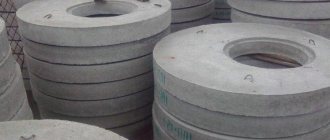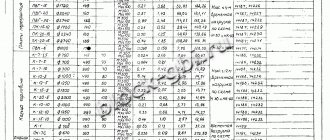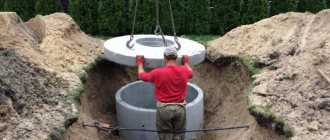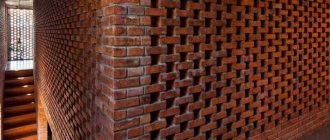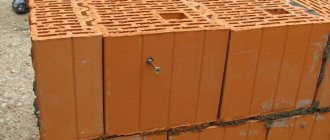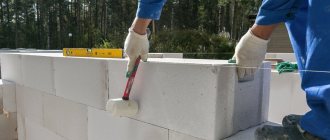The well cover is reinforced concrete - a round slab of reinforced concrete with a designed hole for installing a hatch. Products may differ in height, hole size, outer diameter and sometimes in shape (some are square, for example).
The concrete cover is an important structural part of any prefabricated well; it is installed directly on the ring with reliable fixation with a cement mixture. For ease of installation, the covers are equipped with mounting loops around the perimeter. Afterwards, a hatch is mounted on them, allowing for maintenance and operation of the structure.
Concrete covers are usually important structural elements of water supply and sewer systems. The product protects the well shaft from the risk of precipitation, dirt, dust, and debris getting into it. In addition, the cover significantly increases the level of operational safety of the structure, eliminating the possibility of animals and people falling into the shaft. Often, wells without covers are prohibited from being put into operation.
Before choosing covers for wells, you need to carefully calculate everything, determining the main parameters and requirements for the product. It is important to know the required type of element and design features, diameter, height, thickness, requirements for strength, durability, etc.
Application and Description
A reinforced concrete well cover is a flat standard product with a technological hole for servicing networks or structures. The presence of a protective cover is a prerequisite for the operation of the well.
Compared to covers made of plastic, wood and iron, reinforced concrete products provide maximum protection for the structure.
Reinforced concrete covers are used to construct wells for water supply, gas and sewerage networks, drainage wells and ventilation communications.
The main function of reinforced concrete well covers:
- protection of wells from weather influences and direct sunlight;
- preventing debris from entering communication networks;
- significantly reducing the risk of falling into a well (people or animals);
- protection against unauthorized access to communication systems;
- preventing the collapse and breakdown of communications from subsidence and landslides.
These products are made from high-strength concrete using modern technologies.
As a result of vibration pressing, parts acquire properties such as resistance to low temperatures, water resistance and can be used for several decades.
Due to the reinforcement, increased impact resistance is achieved and the risk of deformation and destruction of the well structure is eliminated.
Types and sizes of well concrete rings
Concrete rings are used in the construction of water supply systems for residential buildings and cottages, gas pipelines, inspection, waste and sewer systems, in the industrial and domestic spheres. Product design features:
- additional;
- wall;
- prefabricated;
- and a quarter;
- with bottom;
- with lids, etc.
Types of rings
Additional elements are used if the dimensions of standard rings are not suitable. Supporting (auxiliary) structures facilitate the construction of objects that are not a multiple of the height of standard well rings. The standard sizes of the rings correspond to standard products, but are smaller in height. Products are manufactured to order.
Reinforced concrete through structures perfectly cope with their tasks when arranging drainage, sewer, network water supply and gas pipeline wells. Product diameter: 70 cm, 1m, 1.5m, 2m, 2.4m, 3m. Height: 30, 50, 60, 90, 120, 150, 180, 200 cm.
Wall devices provide the creation of a neck; they are used for all types of wells: sewer, water and gas. Size: D 0.7 x H 0.3 to D 2 x H 0.9, weight from 135 to 1500 kg.
To prevent the possibility of displacement of the rings after installation, special grooves are installed on them that prevent the moment of displacement. To achieve maximum strength and service life, experts recommend giving preference to vibrated, steamed and reinforced products with a wall thickness of 10-11mm that does not allow water to pass through. Installing the first element with a bottom will provide an increased level of sealing.
Reinforced rings
The reinforcement of the product is made by vibration pressing, similar to standard designs. After pressing, the products take on a dense and uniform appearance, allowing them to maintain their shape and be waterproof. When constructing reinforced rings, they are fastened with a cement mixture, helping to minimize the penetration of water into the soil. To develop reinforced concrete rings, factory conditions are required. Improved techniques help to obtain a perfectly even coating on structures and reliability in use. The cost of rings is determined by their diameter.
How to decide on the size?
The parameters of all elements of the well (rings, covers, bottoms, clamps and rivets) are determined by its type and purpose. The rings must have the same parameters (length and cross-section), the lid and bottom must have similar parameters in a horizontal section. To avoid confusion in the parameters of the rings, special markings are used. It allows you to find out the height and diameter of products.
Standard ring dimensions:
- cross section 700 – 2500 mm;
- length 700 - 1200 mm;
- walls 80 - 120 mm.
Additional elements with non-standard dimensions are developed to special order. The mass of the rings is determined by their dimensions. The smallest weigh 40–45 kg, and the largest weigh 1500 kg.
Attention! For arranging drainage wells, reinforced rings are an ideal option.
How are well rings marked?
To determine the parameters of the rings, use the GOST 8020-90 rule, where the letter values are indicated:
- KS – rings for walls;
- PO - floor slabs;
- PD – panels for installation on roads;
- PP – floor panels;
- PN – panels for arranging the bottom.
Digital values determine the cross-section and height of the rings (for example, KS 15.9 are rings for walls with a cross-section of 1500 mm and a length of 900 mm).
Design features
The main components of wells include rings and covers, determined by their functional features.
Well rings contribute to the formation of the trunk and neck of the structure, the bottom and lid ensure their strengthening. The diameter of the rings varies from 80 to 200 cm in increments of 50 cm, the height varies from 70 to 90 cm, with structures 120 cm high having the highest parameters.
To equip the water supply system, products marked KS8-7 are used, and well devices KS10-9 are less commonly used. They cope well with their tasks when arranging shallow pits. KS 8-7 rings allow you to increase the depth of wells. Maka KS 8-7 indicates lower weight, which simplifies self-installation.
For sewer systems, reinforced concrete rings KS10-9, KS15-9, KS20-9 are used. For revision and prefabricated engineering solutions, models KS15-9, KS10-9, KS8-7 are used. To carry out repair work (deepening) of the well, KS6-7 structures are used. Considering the possibility of covering them with a hatch, the selected structures can serve as the neck of a well.
When creating a prefabricated well with a shallow shaft to accommodate the first ring and subsequent deepening by hand, it deepens under its own weight. The following components are laid on top of it until the specified depth of the well is reached. The areas for joining reinforced concrete rings are treated with a concrete mixture and then covered with a lid - a reinforced concrete slab with a hole. Well covers are marked: PP6-2, PP8-2, PP20-2-1, PP15-2, PP10-2. Their cross-section varies from 1160 to 2500 mm, and their weight ranges from 250 to 3000 kg.
A reinforced concrete glass is a ring with a bottom, presented in the form of a monolithic structure that provides the functions of a foundation. Products are marked KCD.
Attention! When purchasing rings for a well, experts recommend giving preference to the M500 brand of concrete.
Additional items
For ease of use and ease of installation, additional accessories are used. They can be supplied when ordering rings or sold separately.
Dimensions of rings with bottom (DK)
When arranging reinforced concrete structures, it is important to provide for the maximum level of tightness of the erected structure. This is facilitated by monolithic rings with a bottom. Externally, they are presented as solid products that prevent the possibility of leakage of accumulated sewage due to the presence of a lower monolithic element.
Dimensions of rings with lock
Monolithic structures are distinguished by the presence of recesses and protrusions at the top and bottom of the ring. This makes it easier to align parts vertically and prevents horizontal movement. A high level of moisture resistance is achieved thanks to the tightness of the interlocking joint.
Quarter Ring Markings:
For example, the KS-15-9ch option is considered, where
- KS - through ring;
- 15 — flow area;
- 9 - length;
- H - presence of a lock (quarter).
Well covers (PC)
Based on the purpose of the well, a hole for a hatch is required to provide convenient access to engineering solutions. This is facilitated by cylindrical reinforced concrete structures, closed at the top with a lid with a hole for a hatch (made of cast iron or sand-polymer mixture).
Positive characteristics of reinforced concrete cap rings include:
- monolithic connection of the ring with the lid;
- durability ensured due to the strength of the materials (concrete mixture and steel reinforcing elements for the frame);
- ease of installation.
Bottom plate
The bottom slab is structurally represented by a monolithic reinforced concrete slab used for waterproofing the well. When purchasing a bottom, you should take into account the load placed on it. In some cases, the use of heavy grade concrete and reinforcement with reinforcement is required. Marking of structures is presented in letters (PN - product type) and numbers (PN7, PN10, PN15 and PN20).
Thus, the product PN 15 is used for wells with an internal cross-section of 150 cm, and PN 10 for wells with an internal diameter of 100 cm.
Floor panels (PP)
Concrete panels with a round opening for mounting a hatch (made of cast iron or sand-polymer mixture). It provides access to water and sewerage communication solutions. Floor slabs with hatches prevent contamination of wells and protect people from accidentally falling into them. The sizes of plates of different markings have different values, but the holes for mounting the hatch correspond to standard parameters. This allows the hatch to be arranged in accordance with regulations.
Floor slab brands:
- PP10-2;
- PP15;
- PP20-1;
- PP with a hatch made of a polymer-sand mixture (PP 10-2 with LPP).
Support ring dimensions (KO)
The installation of structures is carried out at the neck of the well, allowing the mark of the hatch with the cover to be brought to the design value. They are used for repair work and reconstruction of highways, making it possible to ensure that the level of road surfaces matches the height of the well. The absence of support rings is only allowed when the well is located far from the highway and places where pedestrians move.
Well houses
The houses serve to provide decorative properties and prevent the formation of silt at the bottom, avoiding annual cleaning.
The house protects the water in the well from debris, allowing you to save money on installing filter systems. Sun protection prevents the growth of organisms and bacteria by preventing the water from heating up. In winter it cannot freeze. A closed well increases the level of safety for the child.
The house is equipped with a shaft for the cable on bearings, which simplifies the process of extracting water from the well. The water container is placed inside the structure, which allows you to get water at any convenient time. Galvanized houses are resistant to natural precipitation and have a long service life.
Attention! To install the houses, the preliminary installation of an octagonal washer is required, which covers the upper ring.
Types of houses:
- steel;
- concrete;
- metal-plastic;
- from lining;
- forged;
- made of logs (oak or pine);
- from the block house.
Production and installation
Well rings are represented by standard reinforced concrete products, developed in accordance with GOST 802090. The material for production is concrete mortar, used for arranging deep structures in low-aggressive environments.
When choosing reinforced concrete rings, the design characteristics are taken into account. For example, elements for wells located on highways require equipment with floor slabs and hatches. To achieve a given level of moisture resistance of products, monolithic structures with a bottom are used. The connection of individual reinforced concrete rings is ensured by metal brackets. Supporting products allow you to bring the well to a given level.
Installation of rings is carried out in one of the convenient ways:
- construction option, using construction equipment to dig a pit;
- non-industrially by uniformly undermining the soil along the entire perimeter of the structure.
When purchasing reinforced concrete rings, you should decide on the delivery method. Modern manufacturers offer delivery of trucks and equipment with a crane for unloading and installing elements.
Video
aqua-tehnik.ru
Existing types
Varieties of reinforced concrete covers for wells differ in shape, type of ends and the presence or absence of holes.
Cover shape
The shape of the cover is determined by its functional purpose and the shape of the shaft. She may be:
- square;
- rectangular;
- round.
The ends of the cover are:
- smooth;
- with a quarter: the cover is provided with grooves and projections to facilitate installation on a ring with a locking connection. The rebated profile under the lower part of the ring is intended for installing a drainage grid.
Presence of holes
Based on the presence of holes, the following cover models are distinguished:
- deaf;
- with a through hole, located in the center or offset from the center (more convenient for servicing the well);
- with two holes (most often used for constructing cesspools and septic tanks).
The shape of the holes on the lid can be:
- round (increase the strength of the product);
- rectangular;
- square (suitable for installing drainage grates in sewerage systems).
ATTENTION! The diameter of the round hole must be at least 0.7 m to allow access for maintenance by a technician. If the lid is square, the length of its sides should also not be less than 70 cm.
IMPORTANT! The shape of the cover hole can be changed using a diamond grinding wheel.
Manufacturers and prices
The popularity of plastic lids is growing, and new manufacturers with decent products are appearing on the domestic market. And well-known companies are expanding their range.
St. Petersburg Egida
Egida covers are made from high-density polyurethane foam. They are suitable for covering concrete rings of septic tanks, wells and compost pits with a diameter of 1200 mm. Product thickness – 20 mm, outer diameter – 1.26 m, inner diameter – 1.22 m.
Cap Features:
- spherical shape;
- comfortable and practical sides;
- a flat circle with a diameter of 430 mm in the center for installing decor;
- optimal gap between the edge and the sides;
- high thermal insulation.
You can order the product on the manufacturer's website. The price of the lid in St. Petersburg is 3,750 rubles, in Moscow – 3,950 rubles, in other cities – 4,500 (including delivery). There are discounts for wholesale buyers.
"Ekoprom" from St. Petersburg
The company works with individuals and legal entities and offers plastic covers for wells of any diameter. The product is multifunctional; it can be equipped with bends or strengthened pumping equipment.
Product Detail:
- tight fit of the lid to the well;
- the existing stiffening ribs allow the lid to be used as a stand for garden flowers;
- aesthetic appearance.
The manufacturer offers to buy green lids. But if you order 10 pieces or more, you can choose the color you need. The greatest demand is for lids with a product height of 160 mm and a diameter of 1260 mm. Today, the retail price of such a lid is 4,100 rubles when shipped in St. Petersburg.
Standardpark Companies
The company specializes in surface drainage systems. It offers garden manholes in several colors and designs. They are made from polypropylene, plastic, and polymer compositions. The diameter of the hatches is 780 mm. The cost of the product is from 2,000 rubles. The kit includes a body and a cover.
Kharkov hatches from
The plant produces high-strength manhole hatches in several colors. Buyers can choose the hatch class and its shape. They offer round and square hatches. They provide access to hidden communications and are suitable for different types of utility networks. Case diameter – 790 mm, cover – 685 mm. The price of such hatches is from 1,200 rubles.
Advantages and disadvantages
A reinforced concrete well cover has the following positive properties:
- long service life. The durability of reinforced concrete covers is explained by manufacturing technology. High-quality raw materials are vibrocompressed, and the finished product is dried with hot steam. The finished design is highly reliable and durable. The installed cover can be used to lay road surfaces without the risk of subsidence or destruction;
- resistance to precipitation, ultraviolet radiation, frost, high temperatures and pests;
- resistance to rotting, fungus and mold;
- simplicity and ease, high speed of installation. The large mass of the products is not an obstacle to their quick installation, including with your own hands. On the other hand, the massiveness of the structure does not allow it to be accidentally moved, which increases the safety of the well’s operation;
- high environmental qualities. Reinforced concrete is non-toxic and safe for human health and the environment. Reinforced concrete covers can be used for water supply wells and come into contact with drinking water;
- a variety of types of covers (in shape, size, presence of holes, etc.) allows you to select a model for each well structure;
- durable protection of communications: the heavy weight of the cover minimizes the risk of its accidental displacement;
- the presence of sling loops.
The disadvantages of reinforced concrete covers of well structures include the following:
- price (from several thousand rubles);
- heavy weight, which determines the need to involve several people and special equipment for installation;
- low aesthetics;
- strict manufacturing technology - otherwise the lid may not be strong enough or difficulties may arise in making a hole in the lid.
Types and features of covers for wells
To choose exactly the coating that will ideally protect your well, you need to consider all the options and become familiar with their advantages, disadvantages and features.
First of all, it is worth noting that you can make such a coating yourself only for a mine structure. It is also worth noting that sewer covers and well covers where drinking water is present are different.
As a rule, sewer wells are covered with concrete, plastic, wooden or cast iron covers.
As for well slabs, they, unlike sewer slabs, are not attached to the structure and are smaller in size. The materials used for both types are the same.
Manufacturing techniques
For the production of well covers, heavy concrete class B15/B20 is used. The compressive strength class is determined by the size of the product and its scope of application.
Concrete solution is poured into a mold with a reinforcing frame. For the manufacture of a reinforced frame, carbon thermally strengthened steel At IIIC, IVC, hot-woven rod steel of classes AI, II, III or mesh of welded hot-rolled wire of class BpI, made by resistance spot welding, are used.
Important! The metal elements of the cover must be treated with anti-corrosion agents.
The requirements for the manufacturing method of reinforced concrete products of this type are set out in GOST 8020 90. Well covers must meet the specified requirements for:
- anti-corrosion protection;
- rigidity,
- tempering and design strength,
- resistance to crack development;
- waterproof;
- resistance to frost;
- the grade of steel used (from which the reinforcement and products placed in the structure before concreting are made);
- thickness of the concrete layer in front of the reinforcement.
How to choose a well cover
A well cover is a fairly large-scale purchase. Due to the large weight of the product, its installation and dismantling requires large financial resources and labor costs. Therefore, it is necessary to carefully approach the choice of this product, double-check all the parameters before purchasing in order to immediately make the right choice.
Parameters that must be taken into account when choosing a well cover:
- Dimensions: the lid should coincide with the well in diameter and slightly exceed it. If the lid is smaller, it will not perform its functions; a larger product will require additional financial costs;
- thickness: the standard cover is 10 centimeters thick. If the installation of the product is planned in high traffic areas, a road will pass along the cover, etc., it is recommended to choose a thickness of 20 cm;
- hatch shape: the hole can be round, square or rectangular. A standard well cover has a round hole. The diameter of the round hole must be at least 70 centimeters to allow access for specialist maintenance. Square hatches are most often made for the subsequent installation of a drainage grid;
- location of the hatch opening: in the center or offset to the edge. The hole location option is selected for more convenient operation;
- appearance: the lid should not have such visual defects. such as depressions, scratches, chips, protruding reinforcement, etc.;
- choice of room and storage method: given the large weight of reinforced concrete products, it is permissible to store a maximum of six well covers in a stack, using wooden spacers between the products. Otherwise, under the pressure of the weight, cracks may appear on the covers, which during further operation will cause a leak.
Well hatch
The shape of a concrete hatch for wells is in most cases standard - round, with an average diameter of 70 cm . If necessary, a lid with a square hatch is installed, which is typical for wells with a collar.
Installation of such products is a mandatory condition of operation; proper installation of utility networks in a private home is impossible without them. The use of manholes without neck insulation is prohibited . Hatches are used for arranging drainage systems, storm drains, and sewer systems.
Structurally, the product consists of a shell (rim), which is mounted on the neck of the lid, which protects the structure from external factors.
The following hatches are intended for private use:
- cast iron - SCh20. Installing such a durable and massive model is only advisable if the well will be subject to loads from passing vehicles;
- polymer - these are lightweight, durable and functional products, available at low cost in various colors - the most effective option for your own site;
- concrete - most often used to seal a septic tank, with non-standard dimensions of inspection wells, based on a specific project.
The range of lids is not so large that it is impossible to do it yourself
Hatches with lock
In private homes, such devices protect the system from accidental opening.
The simplest and most reliable locking connections are:
- spacer mechanisms;
- threaded;
- flag.
Product characteristics are indicated in the tabular data.
| Load class | Name | Full opening, D, mm | Load, kN | Weight, kg | Installation depth, mm |
| ST | Hatch extra heavy | 550.00 | 600.0 | 155.0 | 60.0 |
| TM | Trunk heavy | 400.0 | 140.0 | 50.0 | |
| T | Heavy | 250.0 | 120.0 | 35.0 | |
| WITH | Average | 125.0 | 95.0 | 25.0 | |
| LM | Easy | 15.0 | 60.0 | 20.00 | |
| LM | Lightweight and compact | 450.0 | 45.0 |
Marking
Each factory product is marked according to the appropriate standard - letters and numbers.
Reinforced concrete slabs (covers) are marked like this:
- The first digit in the range 1-4 is the size number
- The letters PP mean “floor slab”
- One or two numbers - indicate the outer diameter in decimeters
- One digit after the hyphen in the range 1-3 – indication of load-bearing capacity class
- Optional data - features of the slab: the displacement of the hole is indicated by the letter C, the presence of a figured rebate for the lock ring is identified by the letter H.
The maximum diameter (width) of the cover ranges from 0.8 to 3.3 m, height - within 12-18 cm. The hatch can be included in the kit and is made of one material or another.
PP 20-2 - here is a well floor slab with a diameter of 20 decimeters (200 cm) with a degree of reinforcement (strength class) - 2.
KCP 1-20-2 - here KCP - well floor slab, type of element; 1 — serial number of standard size; 20 — internal diameter; 2 - load-bearing capacity.
Basic information about the reinforced concrete element for covering wells can be obtained from the markings. The corresponding abbreviation indicates the type of engineering communications:
- K - sewerage (sanitary and industrial);
- GK - city sewerage;
- D - drainage or rainwater (storm) sewerage;
- GW, V, VD - city water supply networks
- TS - heating networks
- T - telephone (telephone network);
- G or PG - fire hydrants;
- MG - main gas pipeline;
- GTS is a city telephone network.
On the plates of well covers and manholes intended for sewerage, additional letter markings are applied, for example:
- C - inspection well for maintenance of sewerage systems;
- KP - rotary well (equipped at the turn of the drainage pipe);
- KL - linear well (installed on straight sections along a horizontal line).
Markings are cast on the outer and inner sides of the manhole cover (and on the storm inlet gratings):
- on the outer surface - a symbol in the form of an abbreviation (see above) and a trademark of the manufacturer;
- on the inner surface - the date (month and year) of manufacture.
The dimensions of marking signs are determined by the manufacturer.
The name of the utility networks according to the standard is applied in the center of the cover, the rest of the data is written around the circumference.
Requirements for products of state standards
The requirements that floor slabs (this name, in accordance with GOST, have reinforced concrete covers for wells) must satisfy are established by GOST 8020-2016.
According to this standard they are divided into:
- PPV - floor slabs for water intake wells; PP - floor slabs for control or inspection wells.
Rating of reinforced concrete floor slabs is carried out according to several indicators:
- strength and crack resistance;
- frost resistance and water resistance;
- thickness of the concrete layer to the reinforcement;
- grades of steel used for reinforcement and production of embedded elements;
- protection against corrosion processes.
For the production of reinforced concrete structures it is permissible to use:
- heavy concrete with strength class from B20;
- reinforcing steel (reinforcing bars, hot-rolled bars, reinforcing wire according to GOST 5781, R 52544-2006, GOST 6727-80, TU 14-1-5526-2006).
Floor slab reinforcement frame
Dimensions that concrete well covers can have:
| Slab type | Main parameters, mm | |||
| di | de | h | a | |
| PPV |
| 1000 | 170 | — |
| PP |
|
|
| 150-900 |
- PPV slabs.
Floor slab PPV
- PP plates.
PP floor slabs
Standard markings are used to designate slabs. It consists of letter and number combinations that are arranged in strict sequence.
- Standard size of the product, consisting of the serial number of the standard size, letter designation of the type of plate, external diameter (in decimeters), height.
- Load-bearing capacity group.
- Concrete permeability value, additional parameters.
For example, the floor slab of a manhole with a height of 0.16 m, having an outer diameter of 2.2 m, belonging to the second group in terms of load-bearing capacity, is designated as follows: 2PP22.16-2
In accordance with the requirements of GOST, the installation of prefabricated elements is carried out on a solution of a cement-sand mixture of grade 50 or more in a layer of at least 1 cm. To seal the joints, sealing rings of their elastomers, sealants, CPS, and other materials that meet the requirements of the standards are used.
Working drawings of Series 3.900.1-14 of some slabs are shown in the photo:
Installation
There is nothing complicated about installing a reinforced concrete well cover. The main thing is to maintain maximum precision and accuracy at every stage. If a heavy, large-sized product is being installed, it makes sense to take care of the loader in advance and think about how many people will need to be involved in the work.
First of all, it is necessary to seal each seam of the inlaid “trunk” of the mine. The cover is installed on the upper ring of the concrete well. The joints of the upper cut of the ring must be sealed hermetically. To do this, use a moisture-resistant sealant that is not susceptible to precipitation. The hole in the slab must be closed with a hatch (if this element was not originally installed by the manufacturer). Hatches differ in the material they are made of: concrete, cast iron, plastic, etc. If you plan to install a well element in a high-traffic area or on a highway, it is better to choose an option made of cast iron.
The cover is attached to the well ring using cement mortar.
ATTENTION! If a slab with seams is used during installation, a hemp rope must be laid around the perimeter.
Concrete covers for wells are necessary to securely cover the structure. These products, easy to manufacture and install, will provide long-term protection to the constructed structure.
Cover with metal frame
There are ready-made plugs on sale, made entirely of metal, but due to their heavy weight (at least 25 kg), private drinking wells are rarely covered with them.
You can use a metal corner to make the frame of the lid. The parts are welded together, coated with anti-corrosion primer and enamel or paint (there are compounds that additionally protect against rust). The frame can be covered with wood or textolite.
On the left is a metal cover with a hatch, on the right is a concrete cover with a metal hatch.
How to make it yourself
The decision to make a reinforced concrete cover yourself, for example, for a sewer septic tank, is often driven by the desire to save money. The amount saved includes not only the price of the product itself, but also the cost of the forklift service. A homemade cover will not have the same high strength as a factory one, but in some situations, for home wells, this is acceptable.
Let's look at an example of how to make a reinforced concrete well cover yourself.
Necessary materials
To make a blind reinforced concrete cover you will need:
- concrete grade M200 (B15);
- reinforcement bars;
- boards for formwork;
- polyethylene film.
- In an open area, you need to dig a trench approximately 10 centimeters deep. The diameter of the trench must match the diameter of the upper ring of the well.
- Formwork is installed in the trench. Its boundaries must coincide with the boundaries of the trench.
- The bottom and walls of the formwork structure are covered with polyethylene film.
- Pour the first layer of concrete about 5 centimeters thick.
- The reinforcement is being laid.
- A second layer of concrete about 5 centimeters thick is poured.
- The concrete product is thoroughly dried. Depending on the weather, after a few hours it can be moved indoors for faster drying.
To make a cover with a hole, it is necessary, in addition to the external formwork, to install an internal formwork of the required dimensions, round or square, in the center of the trench.
A reinforced concrete cover is an important structural element of any type of well. Simple in shape and easy to install, it perfectly performs its protective functions and serves for many decades.
Wooden cover
Manufacturers most often use cheap types of wood, such as pine, to make well covers. For self-production, you can take aspen, oak (preferably stained), larch, spruce, birch. For the plug, boards 2-3 cm thick and approximately 15 cm wide are suitable. To connect them, you will need 4 x 4 cm bars. Instead of boards, you can buy a furniture board.
A wooden lid is quite simple to make - you only need the simplest tools and boards.
Step-by-step instructions for making a removable wooden cover for a well:
- Place the bars parallel to each other. Their length must correspond to the internal dimensions of the head.
- Place the boards tightly butt-to-butt onto the bars.
- For strength, nail another 1 bar diagonally between the bars.
- If you need to give the product the shape of a circle or hexagon, then apply markings to the resulting shield and cut it with a jigsaw or a hand router.
- Fill the gaps between the boards with wood sealant.
- Sand the product with sandpaper manually or with power tools (grinder, drill with a special attachment, etc.).
- Treat the finished plug with 2 layers of stain or wood impregnation to prevent moisture and rot. It is better to choose compounds with a water-repellent effect. You can use a mixture of propolis and sunflower oil (1:3).
- Cover with varnish.
- Attach 2 handles to the edges.
A wooden lid with a door is much more convenient to use, but its manufacture will require much more time.
It is more convenient to use a plug with a hatch or doors.
Features of the manufacture of such products:
- Between the bars holding the boards together, the third is not nailed, but a hole is cut out.
- You can make a door from a cut-out fragment (then you can achieve an exact match of the shade and texture of the hatch and the base) or other material. Just as when making a whole lid, fill the frame of 3 bars with boards. Treat the door with impregnation and varnish, and sand it.
- The size of the door is selected taking into account the fact that the hinges will be attached to the hole. The bars connecting the boards of the base of the lid should protrude half their thickness beyond the edges of the cutout; this is necessary to create support for the hatch. Another option is to have an overlay door that is larger than the opening (then less rainwater will get into the gaps).
- You can use overhead hinges for gates. They are screwed to the lid and door.
Regardless of the type of wood chosen, a wooden cover for a well will last at least 5 years.
